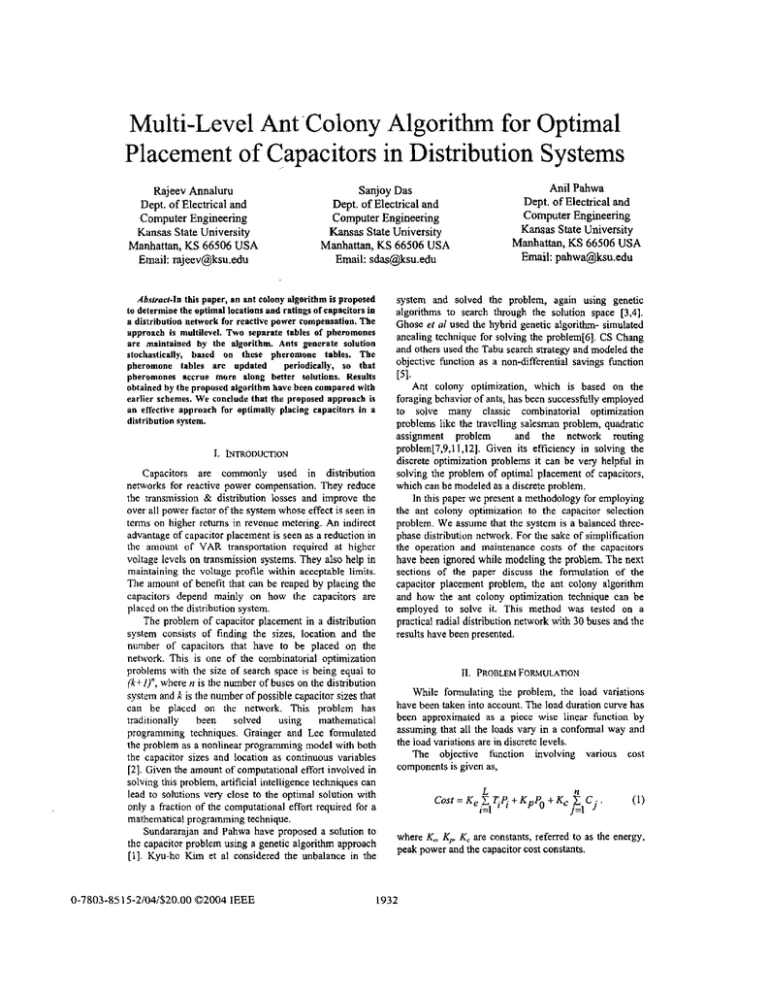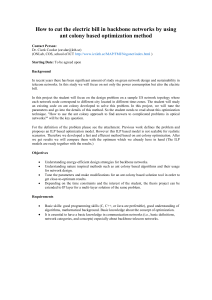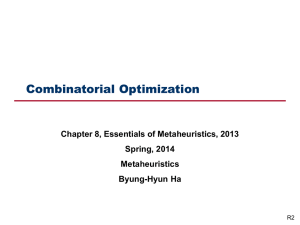Multi-level ant colony algorithm for optimal placement of capacitors
advertisement

Multi-Level Ant Colony Algorithm for Optimal
Placement of Capacitors in Distribution Systems
~
Kansas State University
Dept. of Electrical and
Computer Engineering
Kansas State University
Ani1 Pahwa
Dept. of Electrical and
Computer Engineering
Kansas State University
Manhattan, KS 66506 USA
Email: rajeev@ksu.edu
Manhattan, KS 66506 USA
Email sdas@ksu.edu
Manhattan, KS 66506 USA
Email: pahwa@ksu.edu
Rajeev Annaluru
Dept. of Electrical and
Computer Engineering
Sanjoy Das
Absfrocl-In this paper, an ant colony algorithm is proposed
to determine the optimal locations and ratings of capacitors io
B distribution network far reactive power compensation. The
approach is multilevel. Two separate tables of pheromones
PTO maintained by the algorithm. Ants generate solution
stochastically, based on t h e e pheromone tables. The
pheromone tables are updated
periodically, so that
pheromones accrue mure along better solutions. Results
obtained by the proposed algorithm have been compared with
earlier schemes. We conclude that the proposed approach is
an effective approach fur optimally placing capacitors in a
distribution system.
system and solved the problem, again using genetic
algorithms to search through the solution space [3,4].
Ghose er a/ used the hybrid genetic algorithm- simulated
anealing technique for solving the problem[6]. CS Cbang
and others used the Tabu search strategy and modeled the
objective function as a non-differential savings function
PI.
1. INmODUCTlON
Capacitors are commonly used in distribution
networks for reactive power compensation. They reduce
the transmission & distribution losses and improve the
over all power factor of the system whose effect is seen in
terms on higher returns in revenue metering. An indirect
advantage of capacitor placement is seen as a reduction in
the amount of VAR transportation required at higher
voltage levels on transmission systems. They also help in
maintaining the voltage profile within acceptable limits.
The amount of benefit that can be reaped by placing the
capecitors depend mainly on how the capacitors are
placed on the distribution system.
The problem of capacitor placement in a distribution
system consists of finding the sizes, location and the
number of capacitors that have to be placed on the
nehvork. This is one of the combinatorial optimization
problems with the size of search space is being equal to
(k+l)”, where n is the number of buses on the distribution
system and k i s the number of possible capacitor sizes that
can be placed on the network. This problem has
traditionally
been
solved
using
mathematical
programming techniques. Grainger and Lee formulated
the problem as a nonlinear programming model with both
the capacitor sizes and location as continuous variables
[2]. Given the amount of computational effort involved in
solving this problem, artificial intelligence techniques can
lead to solutions very close to the optimal solution with
only a fraction of the computational effort required for a
mathematical programming technique.
Sundararajan and Pahwa have proposed a solution to
the capacitor problem using a genetic algorithm approach
[I]. Kyu-ho Kim et al considered the unbalance in the
0-7803-8515-2/04/$20.00 02004 IEEE
Ant colony optimization, which is based on the
foraging behavior of ants, has been successfully employed
to solve many classic combinatorial optimization
problems like the travelling salesman problem, quadratic
assignment problem
and the network routing
problem[7,9,11,12]. Given its efficiency in solving the
discrete optimization problems it can be very helpful in
solving the problem of optimal placement of capacitors,
which can be modeled as a discrete problem.
In this paper we present a methodology for employing
the ant colony optimization to the capacitor selection
problem. We assume that the system is a balanced threephase distribution network. For the sake of simplification
the operation and maintenance COSIS of the capacitors
have been ignored while modeling the problem. The next
sections of the paper discuss the formulation of the
capacitor placement problem, the ant colony algorithm
and how the ant colony optimization technique can he
employed to solve it. This method was tested on a
practical radial distribution network with 30 buses and the
results have been presented.
11. PROBLEM
FORMULATION
While formulating the problem, the load variations
have been taken into account. The load duration curve has
been approximated as a piece wise linear function by
assuming that all the loads vary in a conformal way and
the load variations are in discrete levels.
The objective function involving various cost
components is given as,
where K , K p K, are constants, referred to as the energy,
peak power and the capacitor cost constants.
1932
The first term on the right hand side of ( I ) pertains to
the cost arising with different load levels in the system.
Although the loads can acquire any continuous value,
(depending on demand and time of day), we have, for
simplicity, assumed, L discrete load levels as discussed
earlier. The energy consumed in each load level i is a
product, PiTs,
where Piis the power loss at, the load level i
and 7: is the time.duration for which the load persists in
the system. Although not explicitly shown, the peak
,power depends on the capacitors that have been placed in
the feeder’s buses, and to compute them requires
computationally intensive load flow calculations. The cost
component associated with second term, which is linearly
related to Pois the peak power loss. The last term involves
the cost of the capacitors. As mentioned previously, the
operation and maintenance costs of the capacitor banks
have been ignored and only the fixed purchase and
installation costs have been considered. Hence we assume
that the capacitor cost is proportional to its KVA rating C.,
111. ANT COLONY OPTlMlZATlON
The ant colony approach is a stochastic algorithm for
combinatorial optimization that is derived from the
foraging behavior of ants. Despite their extremely
simplistic behavior, ants in the real world cooperate to
obtain an optimal path from their nest to a food source.
This is accomplished by means of special secretions
called pheromones, which enables the ants to interact with
one another. Pheromones are deposited along the trails
taken by the ants. They also evaporate uniformly over
tinic. Eventually, pheromones accumulate more along the
optimal trails.
Ant colony algorithms make use of the tables of
pheromones to record the optimality of assigning
particular values to the various components that make up
a solution [8,9]. The entries of the pheromone tables are
updated periodically based on the cost of the solutions.
When the cost of a solution is low, the corresponding
entries in pheromone tables are incremented by a larger
amount. The ant colony algorithm was originally
proposed as a method for the traveling salesperson
problem, where the problem is also one of determining a
minimum distance path. Subsequently it has been also
shown to work well for other complex optimization
problems [10,1 I].
In each iteration of the algorithm, new solutions are
generated. Although the search process is random, the
algorithm is biased towards assigning values to the
individual components of a solution, which have higher
concentrations of pheromones in the pheromone tables. In
this manner, the search is restricted to better regions in the
solution space. Theoretical investigations have shown that
ant colony algorithms are equivalent to gradient descent
within a multidimensional pheromone space (141.
As pheromones accumulate along better components,
the algorithm produces solutions with decreasing costs,
until it is terminated. The lowest cost solution is kept
aside and upon termination, becomes the final output of
the algorithm. It has been shown that mutating the
pheromone tables by adding small random pemrbations
improves the search by preventing premature convergence
to locally optimal solutions [13].
In this paper, the ant colony algorithm, for the optimal
capacitor placement problem is described. Because of the
nature of the problem, the pioposed algorithm maintains
pheromone tables at two distinct levels that are used by
the ants to build solutions. Because of this hierarchy, the
approach will be referred to as a multilevel ant colony
algorithm.
The proposed algorithm creates a new solution by
placing a capacitor at a few of the buses. Unlike in
standard combinatorial optimization problems, a twostage decision is required in deciding the placement of the
capacitors. First, because of various problems associated
with installation and maintenance, power companies
prefer to place capacitors in only a few of the locations.
Hence a set of optimal buses has to be identified within
the feeder where capacitors have to be placed. The second
decision is to decide on the capacitors rating in KVA that
would minimize the total cost. Since commercial
capacitors are available only of fixed ratings (usually 300,
600, 900, or 1200 KVA), a discrete decision has to be
made here too. In order to enable the algorithm simulate
this process, we have designed an ant colony algorithm
that maintains two pheromone tables.
In the proposed multilevel approach, the first
pheromone table is a IXn array of positive numbers. T,.
Henceforth, we will use the subscripts ’1’ and ‘2’ to
denote the level in some of the algorithm parameters.
Using this upper level table, and the total number of
capacitors to he placed, m, which is maintained at a
constant value in the algorithm, the locations of those
capacitors are decided in a stochastic manner. A total o f m
locations are identified by the algorithm one location at a
time. The probability of a capacitor being placed in each
time step in bus location j , . p , ( j ) , is given by the
following equation,
In the above equation, the summation is camed out over
all n buses where capacitors can be installed. Thus the
probability of a capacitor being installed at any location j ,
is proportional to the pheromone deposition in the
corresponding entry of the upper level pheromone table.
The standard roulette wheel method of selection is
implemented to simulate the random process. The bus
1933
locations selected through this process will be denoted as
i1,jl. ...1,.
The next step is to decide the KVA ratings at .the
locations j , , j l . ,.,j m This is done at the second level,
making use of another table of pheromones. This
pheromone table is arranged in the form of a rXn matrix
TI, where R is the number of discrete KVA ratings. The
The pheromone tables are also updated to allow more
pheromones to accrue along optimal entries. The amount
of pheromones deposited is inversely proportional to the
cost of the global best, cost+, . and is carried out
whenever a new global best is found. When j is a bus
location selected for a capacitor corresponding to row r in
T, to be installed, this updating is done as,
probability of assigning a KVA rating Corresponding to
the row r of the pheromone table to the capacitor at each
locationj h , p2( r . j , ) is equal to,
and
In order to determine the capacitor ratings 'from the
probabilities, another roulette wheel selection had to be
performed.
Following the two-stage preliminary assignment of
capacitors to the buses, a local search technique is
invoked to improve the placement further. To each bus j x
where a capacitor is placed, if the KVA rating selected is
the one that corresponds to row r of T,, then the ratings
associated with the adjacent rows r-l and r+l are
examined. The costs of all three possibilities are computed
using numerical load flow simulations, and the rating that
produces the minimum cost (see (I)) is chosen to be the
final assignment. Because of the significant amount of
computation involved to carry out the simulations, only
one pass is allowed for each location, in order of their
appearance in the system.
The algorithm records the best solution obtained since
the first iteration. This solution will be referred to as the
global best solution. The final placement cost at the end of
any given iteration is compared with the global best, and
if it is lower than the latter, the global best is updated
accordingly. When the global best does not improve over
a period of time (h iterations), the pheromone tables are
pemrbed to allow the search to explore further by an
operator called mutation [13]. The mutation operator adds
a randomly generated value to every entry in the tables.
The pheromone tables at both levels are perturbed
according to the fallowing,
T , ( i )= T , ( j ) + P ( - l , U
(4)
and
where { and 5 are two small parameters, and U(-l,l)
is
a uniformly distributed random number in the range [-I,
11.
where p , and p1 are two ant colony parameters called the
evaporation rates, while Q, and Q, are two other
constants associated with pheromone deposition. For all
other entries in either table, only evaporation is performed
as,
T,(1)= (1 - P,)T, (i)
(8)
and
The algorithm is N n for a significant number of iterations
until a good solution is found.
IV. RESULTS
The proposed multi-level ant colony optimization
approach has been implemented in MATLAB and run on
a Pentium IV, 2.4 GH2 processor. The test system is a 30bus radial distribution system with one main feeder and 6
laterals [I] as shown in figure 3. For the system and load
data one is referred to [1,2]. The program uses the
Newton-Raphson load flow technique to calculate the cost
function given in (I). The following cost figures were
adopted during the implementation. Energy cost constant
K, was taken as 30 mills / kwh. The peak power cost and
the capacitor cost constants are taken at K, = $120 / kw /
year and K, = $5 / kvar. The capacitor cost is considered
at a fixed rate of 15% of the total cost on an annual basis.
Although the ant colony approach looks straight
forward, the design of a successful and efficient algorithm
requires a very carefully selected and finely tuned set of
algorithm parameters. The speed of convergence of the
algorithm and the quality of the final solution of any ant
colony optimization technique highly depends on the
1934
~'
choice of the T, p. Q, C and <values. After various trails
and tests, the parameters were set the following values.
The entries of both pheromone tables, TI and T, were
initialized to a value of 4. Any higher value would only
reduce the sensitivity of the pheromone table to the initial
set of ants and delay the convergence. The evaporation
rates p, and p1 was'set to 0.012. Since the pheromone
table was updated only'when a new global best was hit,
higher evaporation rates would lead to premature
convergence. It was observed that in cases where the
evaporation rates were higher than this value, the ants
tend to lose their ability to explore the search space
properly. This would lead to the sub-optimal convergence
of the algorithm. Another crucial parameter Q was taken
as 75 X IO'. The parameters C, 4, a and 8 were set to I .O.
The results shown here are based on the average of 20
runs of the algorithm. The pheromone table was mutated
for every 400 iterations, which did not result in a new
global best value. This resulted in perturbing the
pheromone table and started the exploration from a new
point in the search space. In most of the cases, it was seen
that the pheromone table starts to saturate around 650 to
700 iterations (refer to Figure I ) .
The best solution from this algorithm gave a cost
function value of $212,377.4. This converts into a cost
saving of $40,758 when compared to a hare system
without any capacitors. The result of this ant colony
optimization technique is $1354 better than the method
proposed in [I] which gives an optimized cost function
value of $213731.4. This method also outperforms the
method proposed in [l], in the number of capacitor
placements that are required in the system. Using this
method we obtained a lower cost solution with only 9
capacitors in the distribution system in comparison to the
IO-capacitor placements that are required from the genetic
algorithm method proposed in [I].This would translate
into some additional cost savings from the operation and
maintenance cost of the extra capacitor bank installed on
the system. These costs have been neglected in the
problem formulation for the sake of simplicity.
The genetic algorithm approach discussed in [ I ]
considered a population size of 50 and required on an
average, SO to 100 generations to converge to a solution.
This would translate into a computational effort of 4000 to
5000 cost function evaluations. On the contrary, the
proposed technique required on an average 1000 cost
function evaluations to converge to a good solution.
n
Figure I: A sample run showing the effcct of mutation. It can bc
clearly noticed that thc cost values tcnd lo scttlc around 750
iterations. Howcver, affer the mulation takcs placc around 80Och
iteration, the search is again as intense as it is initially. We can
also see that the phcromone table undergoes another round of
mutation around 12OOrh iteration.
KI
Figure 2: Plot showing thc improvement of the global best valuc
as the simulation progresses. Bcst run, worst run and lhe avcrage
of 20 runs of the algorithm arc shown in the figure.
1935
6
600 KVA
Figurr 3:The 30 bus radial distribution sysw, ued as ales case 0 this wrk is h a w *ul
cost
($1
Capacitors required
Cor1 function
evaluations
Genctic
Algorithm
Ant colonv
optimization
21 3.73 I.4
212377.4
10
9
- 4000
-1000
the 9 capacbors pkcedan
a
VI. REFERENCES
[I]
Table I : A comparison between the genetic algorithm method
adopted in [ I ] and thc ant colony optimization approach.
121
[31
v. CONCLUSIONS
We have proposed an ant colony approach to
determine optimal placement of capacitors in a real 30bus radial distribution network. Our approach can be
extended to other networks also. Since one has to
determine simultaneously the locations as well as the
ratings of the capacitors, a two level strategy was devised.
The ant colony algorithm maintained two pheromone
tables, which ants used when generating solutions. The
tables were updated simultaneously based on the lowestcost solutions obtained. Our approach can be applied to
other practical problems requiring complex decision
making as well.
141
[SI
..
SSundararajan and A.Pahwa, "Optimal selcction of
capacitors for radial distribution system using a
genetic algorithm," IEEE Trans on power sysrem vol.
9, No.3, August 1994.
J.J Graingcr and S.H.Lee, "Optimum size and location
of shunt capacitors for reduction of losses on
distribution feeders," IEEE frons on power apparatus
ondsystems,vol. 100. pp. 1105-1118, March 1981.
Kyu-Ho Kim, Scok-Ku You, "Voltage profile
improvemcnt by capacitor placement and control in
unbalanced distribution systems using GA" Power
Engineering Society Summer Meeting, 1999. IEEE.
vol. 2, 18-22 July 1999, pp:800 - 805.
Kyu-Ho Kim, Sang-Bang Rtiec, Soo-Nam Kim, SeokKu You. "Application of ESGA Hybrid Approach for
Voltagc Profile Improvement by Capacitor
Placement", IEEE trans on power delivery, vol. 18,
No. 4, October 2003
CS Chmg and Lem Poh Lcm, "Application of Tabu
search strategy in solving non-diffcrential savings
function for the calculation of optimum savings due to
shunt camcitor insfallation on a radial distribution
.
reduction in distribution system by capacitor
placemcnt ulraugh combined CA-SA technique",
IEEE Rexion I O Infernorional Conference on Global
1936
Connecrivi?. in E n w e , Computer, Communicarion
ondControl,vol.2, 17-19.Dec. 1998pp: 502-505..
[71 D.Whitley, Tim Starkweathcr and DAnn Fuquay,
”Schcduling problcms and travelling salesman: thc
gcnctic edgc recombination operator”, Proceedings of
the Third lnrernotional Conference on Generic
Algonrhm.s, Palo Alto, Ca.: Morgan Kaufmann, pp;
133.140, I Y ~ Y .
I81 M. Dorigo, V. Maniezza, A. Colorni, “Ant System:
Omimization by a Colony o f Coowrativc Agents”.
IEEE Trans on Systems, Man and Cybernetics, Parr B,
vol.26,pp.2941, 1996.
191 M. Dorigo, L. M. Gambardclla, “An1 Colony Systems:
A Coopirativc Lcarning Approach to thc T k l i n g
. Salcsman Problcm”, IEEE Trans on Evolurionoy
Computorion, vol. 1, pp. 53-66, 1997.
[IO] M. Dorigo, G . Di Cam, Thc Ant Colony Optimization
Meta-Heuristic: in D. Come, M. Dorigo, F. Glover,
cditors, New Idem in Oplimizotion. McGraw-Hill, pp.
11-32, 1999.
[ I I ] M. Dorigo, G. Di Cam, L. M. Gambardella, ”Ant
Algorithms for Discrete Optimization”, Artrficial Lre.
vol. 5,pp. 137-172, 1999.
[I21 S. Das, 1. Mohanly. D. 2. Yang, “An Ant Colony
Algorithm for Multicast Routing in Communication
Networks", Proceedings. 6rh Internotional Join1
Conference on Inlormotion Scienter. Durham. North
~aroiina,2002.
[I31 T. Stutzlc and H. Hoos. “Improvements on the ant
systcm: Introducing MAX -- MIN ant system”. I n
Proceedings of thc lnrernorional Conference on
Artfliciol Neural Nemorkr and Generic Algorithms,
pp: 245--249. Springcr Vcrlag, Wien, 1997.
[I41 Stutzle, T . ; Dorigo, M...“A short convergence proof
for a class of ant colony optimization algorithms". pp:
358- 365, IEEE Transactions on Evolutronay
computorion, VOI. 6, ISSUC: 4, YCX:~ “ 2002.
g
-
1937


